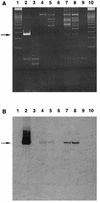Environmental occurrence of the Whipple's disease bacterium (Tropheryma whippelii)
- PMID: 9464419
- PMCID: PMC106114
- DOI: 10.1128/AEM.64.2.760-762.1998
Environmental occurrence of the Whipple's disease bacterium (Tropheryma whippelii)
Abstract
Whipple's disease is a systemic disorder in which a gram-positive rod-shaped bacterium is constantly present in infected tissues. After numerous unsuccessful attempts to culture this bacterium, it was eventually characterized by 16S rRNA gene analysis to be a member of the actinomycetes. The name Tropheryma whippelii was proposed. Until now, the bacterium has only been found in infected human tissues, but there is no evidence for human-to-human transmission. Here we report the detection of DNA specific for the Whipple's disease bacterium in 25 of 38 wastewater samples from five different sewage treatment plants in the area of Heidelberg, Germany. These findings provide the first evidence that T. whippelii occurs in the environment, within a polymicrobial community. This is in accordance with the phylogenetic relationship of this bacterium as well as with known epidemiological aspects of Whipple's disease. Our data argue for an environmental source for infection with the Whipple's disease bacterium.
Figures


References
-
- Benlloch S, Rodríguez-Valera F, Martinez-Murcia A J. Bacterial diversity in two coastal lagoons deduced from 16S rDNA amplification and partial sequencing. FEMS Microbiol Ecol. 1995;18:267–280.
-
- Dobbins W O., III . Whipple’s disease. Springfield, Ill: Charles C. Thomas, Publisher; 1987.
-
- Maiwald M, Kissel K, Srimuang S, von Knebel Doeberitz M, Sonntag H-G. Comparison of polymerase chain reaction and conventional culture for the detection of legionellas in hospital water samples. J Appl Bacteriol. 1994;76:216–225. - PubMed
Publication types
MeSH terms
Substances
Associated data
- Actions
- Actions
- Actions
LinkOut - more resources
Full Text Sources

